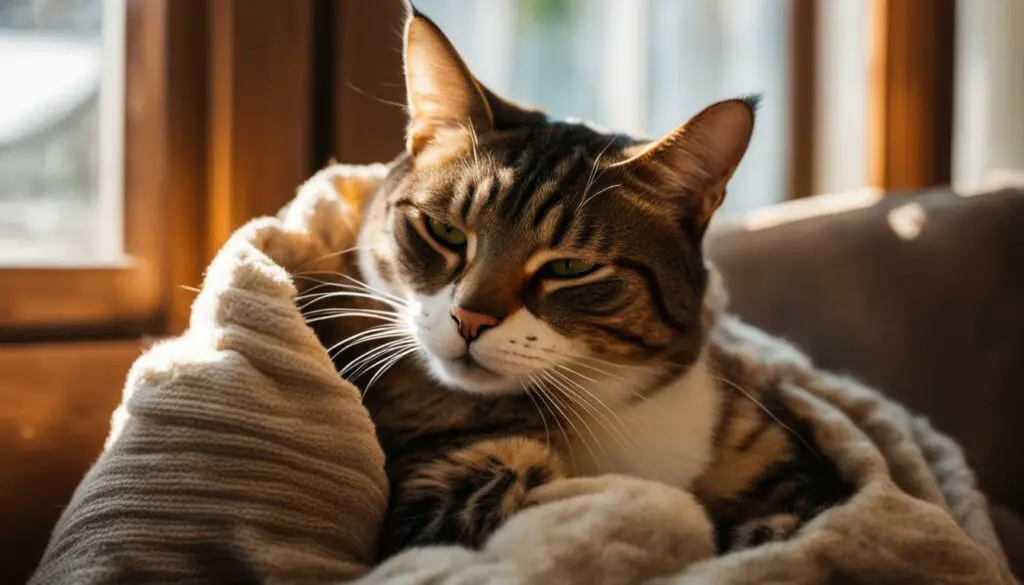Have you noticed a sudden change in your male cat’s behavior? Is he now more affectionate than ever before? Understanding the reasons behind this behavior can help strengthen the bond between you and your furry companion. Let’s delve into the basics of why your male cat is suddenly so affectionate.
It’s not uncommon for cats to exhibit changes in behavior, including becoming more affectionate. This sudden display of love and attention-seeking can be attributed to various factors, such as emotional bonding, attachment, and a desire for companionship. By unraveling the mystery behind your cat’s newfound affection, you can nurture a deeper connection with your feline friend.
Key Takeaways:
- A male cat’s sudden affectionate behavior can stem from reasons such as emotional bonding, attachment, and a desire for companionship.
- Factors like nervousness, insecurity, newness in the household, mommy issues, past trauma, and potential health issues can contribute to a male cat becoming suddenly affectionate.
- Understanding the difference between clingy and demanding cats can help address their behavior appropriately.
- Spending quality time together, providing a stable environment, and addressing loneliness and anxiety can help strengthen the relationship with your cat.
- Considering factors like health, aging, hormones, socialization, and trust can also play a role in reducing clinginess and fostering a healthy bond.
Factors Behind Sudden Affection in Male Cats
Male cats can sometimes exhibit sudden affectionate behavior, leaving their owners wondering what may have caused this change. Understanding the factors behind this behavior can help strengthen the emotional bond between cat and owner. Here are some possible reasons for a male cat’s sudden affection:
Nervousness and Insecurity
Male cats can become clingy and seek affection when they feel nervous or insecure. They may view their owners as protectors and seek comfort and safety in their presence. Changes in the home environment, such as rearranging furniture or introducing new items, can contribute to these feelings of uncertainty.
Newness and Hierarchy
When a male cat is new to a household, he may display clingy behavior as he establishes his place in the hierarchy. They may see their owners as a source of comfort and bonding, seeking their company for security and reassurance. Building trust and providing a stable environment can help ease their clinginess over time.
Mommy Issues
Male cats that were separated from their mothers too early may develop bonding complications, resulting in a strong attachment to their owners. They may see their owners as their true mothers and seek a close bond. Trust-building exercises can help address clinginess in these cats.
Past Trauma and Rescue Cats
Rescue cats often exhibit clingy behavior due to past trauma and trust issues. Their previous hardships can lead them to seek comfort and security by clinging to their owners. Patience, understanding, and providing a stable and loving environment can help these cats overcome their anxiety and reduce clinginess.
| Factors Behind Sudden Affection in Male Cats |
|---|
| Nervousness and Insecurity |
| Newness and Hierarchy |
| Mommy Issues |
| Past Trauma and Rescue Cats |
Nervousness and Insecurity in Male Cats
When it comes to sudden affection in male cats, feelings of nervousness and insecurity can play a significant role. These cats may view their owners as protectors and providers, seeking comfort and safety in their presence. Changes in the home environment, such as rearranging furniture or introducing new items, can contribute to these feelings of nervousness and insecurity.
Male cats are naturally wired to be protectors and may become clingy as a way to cope with their vulnerability. They rely on their owners for a sense of security, especially during times of change or uncertainty. These cats may seek constant attention and affection to feel safe and reassured.
“Male cats may become clingy and affectionate due to feelings of nervousness and insecurity. They may view their owners as protectors and providers, seeking comfort and safety in their presence.”
Understanding and addressing the underlying causes of nervousness and insecurity is crucial in managing clingy behavior in male cats. Creating a calm and stable environment, maintaining a consistent routine, and providing plenty of mental and physical stimulation can help alleviate these feelings and reduce clinginess.
| Signs of Nervousness and Insecurity in Male Cats | Ways to Address Nervousness and Insecurity |
|---|---|
| Vocalization (excessive meowing) | Provide a safe and quiet space for the cat |
| Excessive hiding | Use pheromone products to create a calming environment |
| Overgrooming or compulsive behaviors | Establish a consistent routine and avoid sudden changes |
| Aggression towards other pets or people | Engage in interactive play and provide mental stimulation |
By understanding the impact of nervousness and insecurity on a male cat’s behavior and taking steps to address these issues, owners can help their cats feel more secure and reduce clingy behavior. Building trust and providing a stable, nurturing environment can go a long way in fostering a strong bond with your feline companion.
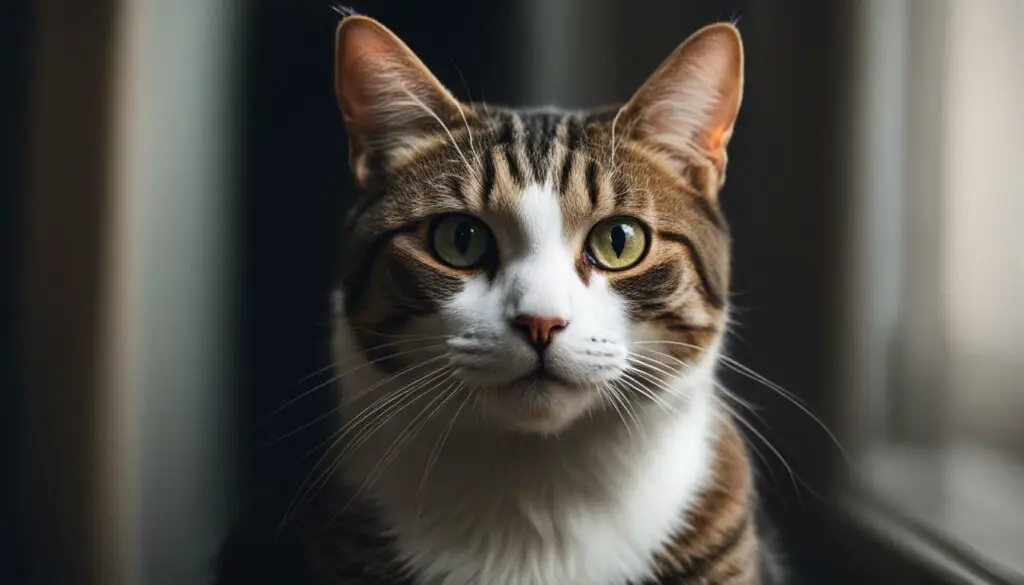
Newness and Hierarchy in Male Cats
When a male cat is introduced to a new household, it is common for them to exhibit sudden affectionate behavior. This is often due to the newness of their environment and their natural instinct to establish a hierarchy within their social group. The male cat sees their owner as a source of comfort and bonding, seeking their company for security and reassurance. Building trust with a new cat can help alleviate clinginess over time.
To better understand this behavior, it is important to consider the concept of hierarchy in cats. In the wild, cats form social groups with a clear hierarchical structure. By seeking attention and affection from their owner, the male cat is trying to establish their place in the household hierarchy, just as they would in the wild. The owner becomes their companion and provider, which helps the cat feel secure in their new environment.
Creating a positive and welcoming environment for the new male cat is key to helping them adjust and reduce clinginess. Providing a designated space for the cat with familiar scents, such as a bed or scratching post, can help them feel more comfortable and establish a sense of ownership. Additionally, maintaining a consistent routine and providing ample opportunities for play and exercise can help redirect their energy and provide a healthy outlet for their natural instincts.
Establishing a Hierarchy and Building Trust
When introducing a new male cat to the household, it’s important to establish a clear hierarchy and build trust gradually. Here are some tips to help with the process:
- Introduce the cat to one room at a time, gradually expanding their territory as they become more comfortable. This allows them to feel in control of their environment and reduces feelings of insecurity.
- Use positive reinforcement, such as treats and praise, to reward the cat for desirable behaviors. This helps build trust and strengthens the bond between the cat and owner.
- Provide ample opportunities for play and interactive toys to keep the cat engaged and stimulated. This helps redirect their energy and prevents them from becoming overly dependent on their owner for entertainment.
By understanding the newness and hierarchy factors in male cats, owners can create a supportive environment that helps reduce clinginess and promotes a healthy bond between the cat and their human companion.
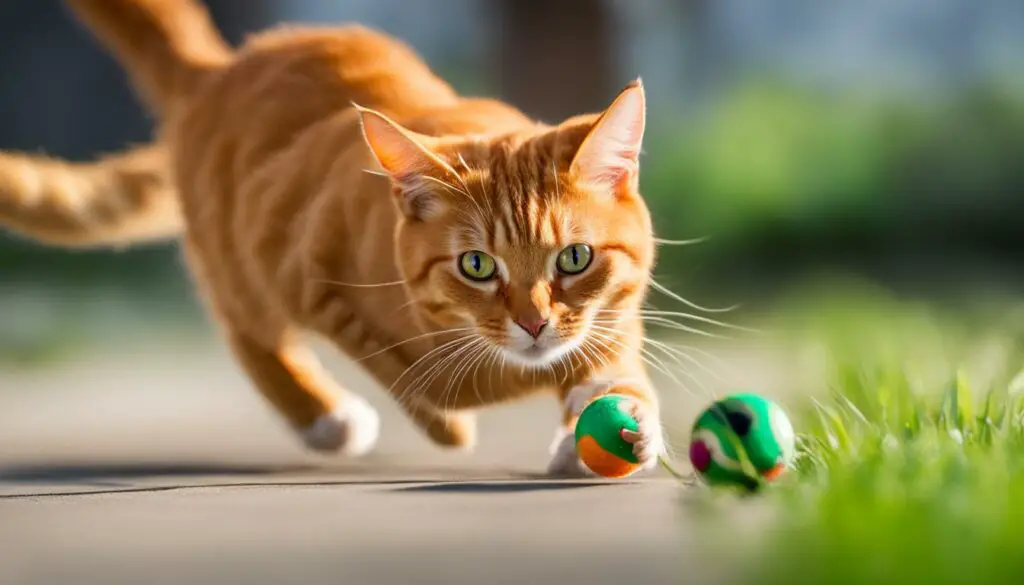
Mommy Issues in Male Cats
Male cats that were separated from their mothers too early may experience bonding complications, resulting in a strong attachment to their owners. These “mommy issues” can contribute to sudden affectionate behavior and increased clinginess. These cats may view their owners as their true mothers and seek a close bond with them.
Building trust is crucial when dealing with male cats that have mommy issues. Patience and understanding are key in helping these cats overcome their bonding complications and reducing their clinginess. Engaging in trust-building exercises, such as interactive play and positive reinforcement, can gradually alleviate their attachment and create a more balanced relationship.
Male cats with mommy issues require extra care and attention. By providing them with a safe and nurturing environment, we can help them feel secure and establish a close bond based on trust and love.
Addressing Mommy Issues: Tips for Owners
- Be patient: Understand that male cats with mommy issues require time to adjust and feel secure in their new environment.
- Provide comfort: Offer soft bedding and cozy spaces where your cat can feel safe and protected.
- Engage in play: Use interactive toys to bond with your cat and create positive associations that help alleviate clinginess.
- Establish routines: Consistency and predictability can help reassure male cats with mommy issues and reduce their anxiety.
- Consult a veterinarian: If your cat’s clinginess persists or becomes excessive, it’s important to rule out any underlying medical issues.
By understanding the impact of mommy issues on male cats’ behavior and taking appropriate steps to address these challenges, owners can build a strong and loving bond with their feline companions.
| Symptom | Description |
|---|---|
| Excessive clinging | Constantly seeking physical contact and attention from the owner. |
| Anxiety when separated | Becoming agitated or distressed when left alone for extended periods. |
| Persistent meowing | Constant vocalization, especially when the owner is not in sight. |
| Difficulty socializing with other cats | Uncomfortable or anxious around other cats, displaying defensive or fearful behavior. |
| Seeking physical contact during sleep | Climbing onto the owner’s bed or sleeping area to maintain close physical proximity. |
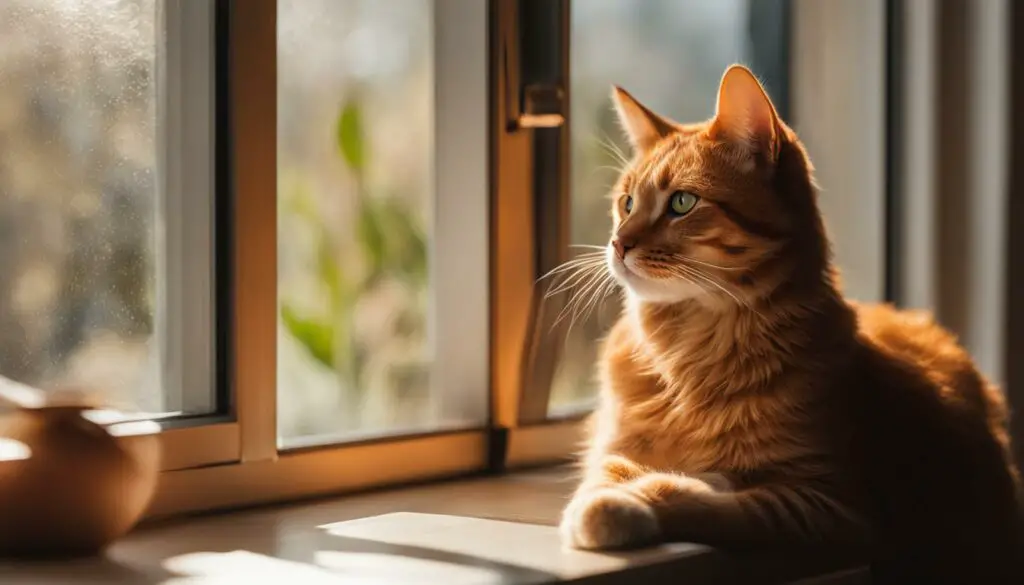
Past Trauma and Rescue Cats
Rescue cats often come with a history of past trauma and trust issues, which can contribute to their clingy behavior. These cats may have experienced abandonment, abuse, or neglect before finding their forever homes. As a result, they have developed fears and insecurities that manifest in their need for constant reassurance and attention.
It is important to understand that these cats have been through a lot, and their clinginess is a coping mechanism to seek comfort and security. Patience and understanding are key when dealing with rescue cats. They require a nurturing environment where they can gradually build trust and feel safe.
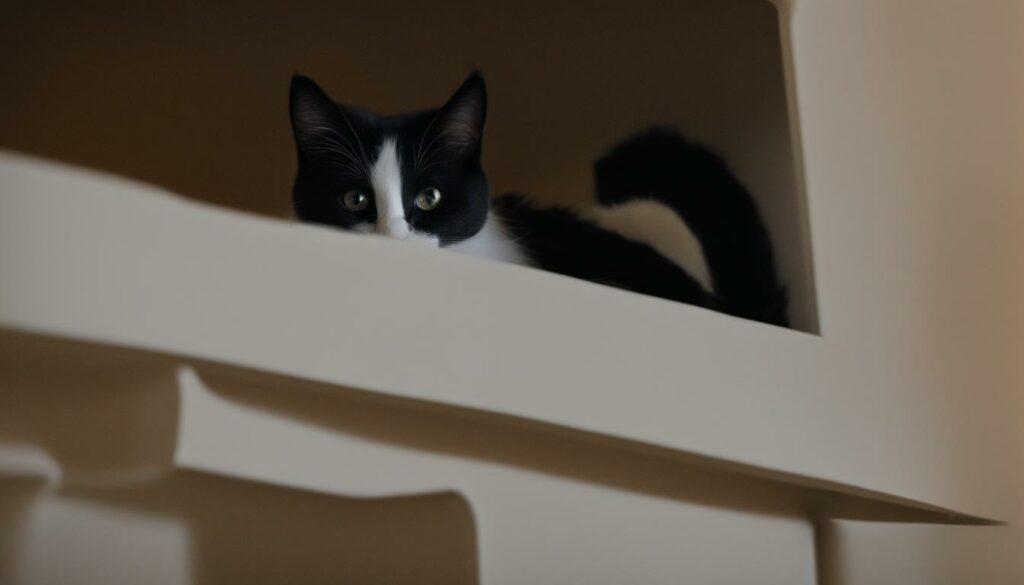
Creating a routine and providing a sense of stability can help ease their anxieties and reduce clingy behavior. Offering a designated safe space with hiding spots, cozy beds, and toys can also provide a sense of security. Additionally, interactive play sessions and positive reinforcement training can help boost their confidence and strengthen the bond with their owners.
Table: Factors contributing to clinginess in rescue cats
| Factors | Impact on Clinginess |
|---|---|
| Past Trauma and Abuse | Causes fear, insecurity, and the need for constant reassurance |
| Trust Issues | Makes it challenging for the cat to let go of their need for constant attention |
| Fears and Anxieties | Leads to clingy behavior as a coping mechanism to feel safe |
Remember, building trust with a rescue cat takes time and patience. By providing a loving and understanding environment, you can help these cats overcome their past traumas and create a strong bond that alleviates their clingy behavior in the long run.
Potential Health Issues in Male Cats
When a male cat suddenly displays heightened affection towards its owner, it could be a sign of underlying health issues. Changes in behavior, such as increased dependence and clinginess, should not be ignored as they may indicate medical problems. It is crucial to schedule a visit to the veterinarian to ensure the cat’s well-being and rule out any underlying health conditions causing this sudden change in behavior.
Medical problems such as pain, injury, or aging can contribute to changes in a male cat’s behavior. Regular check-ups can help manage these issues and provide appropriate treatment options if necessary. It is important to pay attention to any signs of discomfort or unusual behavior, as cats cannot directly communicate their pain or discomfort.
By addressing potential health issues promptly, owners can ensure the physical and emotional well-being of their male cats. Providing adequate medical care can help alleviate clinginess associated with underlying medical problems and promote a healthier, more balanced relationship between the cat and its owner.
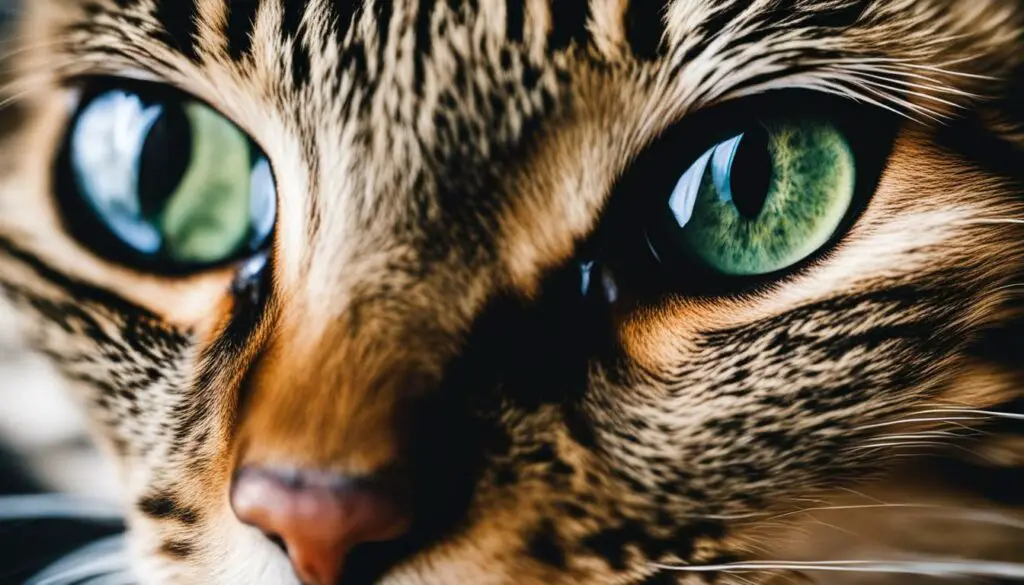
Understanding Clingy vs. Demanding Cats
Cats can display various behaviors that may be perceived as clinginess or demanding behavior. It is important to understand the differences between these two types of behavior in order to address them appropriately and ensure a harmonious relationship with our feline friends.
Recognizing Clingy Cats
Clingy cats seek comfort, security, and attention from their owners. They may exhibit behaviors such as following their owners around the house, always wanting to be near them, or even refusing to eat unless their owners are present. Clingy cats often display a lack of confidence and rely on their owners for reassurance. They may also exhibit signs of anxiety or stress when separated from their owners.
Identifying Demanding Cats
Demanding cats, on the other hand, tend to exhibit more confidence and assertiveness. They may meow or vocalize loudly to get their owners’ attention or to communicate their needs. Demanding cats are often more independent and may display dominant behaviors, such as pushing their owners to do things on their terms. They may demand playtime, food, or even access to specific areas of the house.
Understanding whether your cat is clingy or demanding can help you address their behavior effectively. Clingy cats may require extra reassurance and attention, while demanding cats may benefit from structured playtime and clear boundaries. By providing the right environment and understanding their needs, you can foster a strong and balanced relationship with your feline companion.
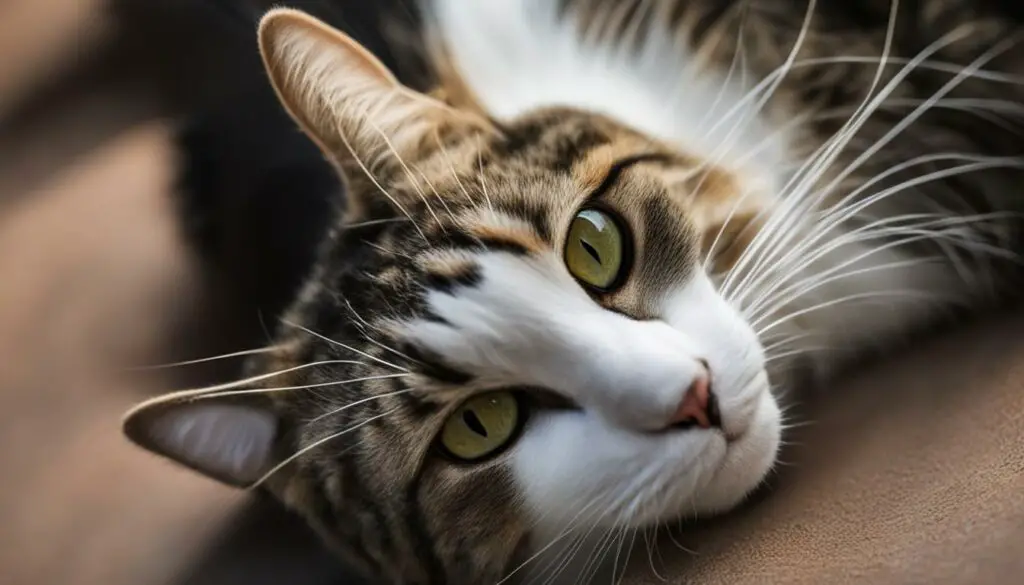
Table: Clingy vs. Demanding Cats
| Behavior | Clingy Cats | Demanding Cats |
|---|---|---|
| Attention-Seeking | Constantly follow their owners | Meow or vocalize to get attention |
| Confidence Level | Often lack confidence | More assertive and confident |
| Independence | Rely on owners for reassurance | More independent |
| Behavioral Demands | Seek comfort and security | Request playtime or specific needs |
| Communication Style | Display signs of anxiety or stress when separated | Meow or vocalize to communicate needs |
Strengthening the Relationship with Your Cat
Building a strong bond with your male cat is essential for a fulfilling and harmonious relationship. Whether your cat is suddenly affectionate or not, there are various ways to strengthen your connection and enhance the companionship you share. Here are some tips to help you nurture that special bond:
1. Spend Quality Time Together
Allocate dedicated time each day to engage in activities that your cat enjoys. This could include interactive play sessions with toys, gentle grooming sessions, or even just lounging together in a cozy spot. These shared moments of playfulness and relaxation create positive associations and reinforce the bond between you and your cat.
2. Provide Physical and Mental Stimulation
Cats thrive on mental and physical stimulation, so it’s important to provide them with opportunities to explore, climb, and play. Invest in scratching posts, interactive toys, and puzzle feeders to keep your cat entertained and mentally stimulated. This not only strengthens the bond between you and your cat but also helps prevent boredom and destructive behavior.
3. Create a Safe and Comfortable Environment
Cats feel most secure in an environment that is familiar and free from stress. Ensure your home provides a safe and comfortable space for your cat by creating designated areas for sleeping, eating, and using the litter box. Additionally, consider using feline pheromone diffusers or sprays to create a calming atmosphere that promotes relaxation and reduces anxiety.
4. Respect Your Cat’s Boundaries
While it’s important to spend quality time with your cat, it’s equally crucial to respect their personal space and individual preferences. Pay attention to their body language and signals to understand when they need space or when they are seeking attention. By respecting their boundaries, you build trust and create an environment where they feel safe and secure.
Remember, building a strong relationship with your cat takes time and patience. By investing in companionship, playfulness, and understanding, you can strengthen the bond between you and your male cat and enjoy a loving and fulfilling connection.
The Importance of Routine and Environment
Creating a consistent routine and providing a stable environment for your male cat is crucial in reducing clinginess and fostering a sense of comfort and security. Cats are creatures of habit, and any disruptions or changes in their surroundings can lead to increased anxiety and clingy behavior. By maintaining a familiar routine, you can help your cat feel more at ease and alleviate their need for constant attention.

Additionally, the environment plays a significant role in a cat’s overall well-being and behavior. Cats are highly sensitive to their surroundings, including scents and pheromones. Creating a calming environment with products like pheromone diffusers or sprays can help reduce anxiety and promote relaxation.
Providing your male cat with a designated space that is filled with familiar scents and comforting objects can also help alleviate clinginess. Cats often seek out areas that have their scent or the scent of their owners, so having blankets or bedding with familiar scents can provide them with a sense of security.
Introducing New Family Members
When it comes to introducing new family members to your male cat, effective communication, socialization, and trust-building are essential. Cats can be sensitive to changes in their environment, and the arrival of a new family member can disrupt their routine and trigger clinginess. By following a few simple steps, you can help ease the transition and reduce clingy behavior.
Creating a Safe Space
One of the first steps in introducing a new family member to your male cat is to create a safe space where your cat can retreat to. This can be a separate room or area of the house where your cat feels secure and comfortable. Fill the space with familiar items like bedding, toys, and scratching posts to provide a sense of familiarity.

Gradual Introduction
When it’s time to introduce your cat to the new family member, do so gradually to minimize stress and anxiety. Start by allowing your cat to sniff and explore the new person’s scent on clothing or personal items. Then, with the new family member sitting calmly, allow your cat to approach at their own pace. Provide positive reinforcement, such as treats or praise, when your cat shows curiosity or calm behavior.
Building Trust and Socialization
Building trust between your male cat and the new family member is crucial in reducing clingy behavior. Encourage positive interactions by engaging in playtime, grooming, and feeding together. This can help create positive associations and strengthen the bond between your cat and the new family member. Additionally, maintaining a consistent routine and providing plenty of attention and affection can help your cat feel secure and reassured during this transition period.
Addressing Loneliness and Anxiety
Male cats may sometimes exhibit increased clinginess due to feelings of loneliness and anxiety. It’s important to understand and address these underlying emotions to help your furry companion feel more secure and content. Here are some strategies to consider:
1. Provide Companionship:
Offering your male cat plenty of quality time and attention can make a significant difference. Engage in interactive play sessions, cuddle, and groom them regularly to help them feel loved and connected. This companionship can help alleviate their loneliness and provide a sense of comfort.
2. Create a Calming Environment:
Designate a quiet and cozy space for your cat where they can retreat and feel safe. Provide soft bedding, toys, and vertical spaces like cat trees or shelves for them to explore and relax. Additionally, consider using pheromone products, such as sprays or diffusers, that can help create a calming atmosphere.
3. Encourage Mental Stimulation:
Keep your male cat mentally stimulated to help alleviate anxiety. Provide puzzle toys, treat-dispensing toys, or hiding spots where they can engage in natural behaviors like hunting and exploring. This mental stimulation can distract them from feelings of loneliness and boredom.
4. Establish a Routine:
Cats thrive on routine and predictability. Establish a consistent daily schedule for feeding, playtime, and quiet time. Having a stable routine can provide a sense of security for your cat and help reduce feelings of anxiety and loneliness.
5. Consider a Feline Companion:
If you have the time, resources, and space, consider adopting a second cat to keep your male cat company. However, it’s important to introduce them properly and ensure compatibility between the two cats. A feline companion can provide companionship and alleviate loneliness, especially if you’re away from home for long periods.
6. Seek Professional Help if Necessary:
If your male cat’s clinginess and anxiety persist despite your efforts, it may be beneficial to consult a veterinarian or a professional animal behaviorist. They can provide further guidance and help develop a tailored plan to address your cat’s specific needs.
By addressing your male cat’s feelings of loneliness and anxiety, you can help them feel more secure, content, and reduce their clingy behavior. Remember to be patient, understanding, and consistent in your approach, as every cat is unique and may require different strategies.
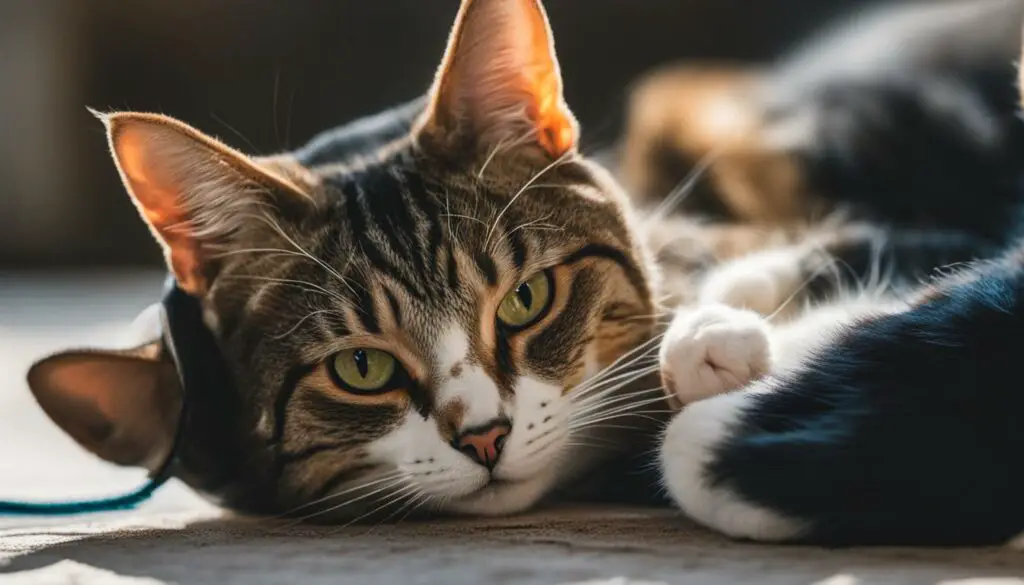
Considering Health and Aging Factors
As our male cats age, it’s essential to pay attention to any sudden changes in behavior, including increased affection. While it can be heartwarming to see our furry companions become more affectionate, it’s important to consider potential health issues that may be contributing to this behavior. Regular veterinarian check-ups are crucial for identifying any underlying health problems that could be causing pain, injury, or discomfort in our senior cats.
Just like humans, cats can experience age-related issues such as arthritis, dental problems, or urinary tract infections. These conditions can lead to increased clinginess as our cats seek comfort and support from us. By maintaining a proactive approach to their healthcare, we can ensure that our senior cats receive the appropriate treatment and support to keep them comfortable and minimize any behavioral changes.
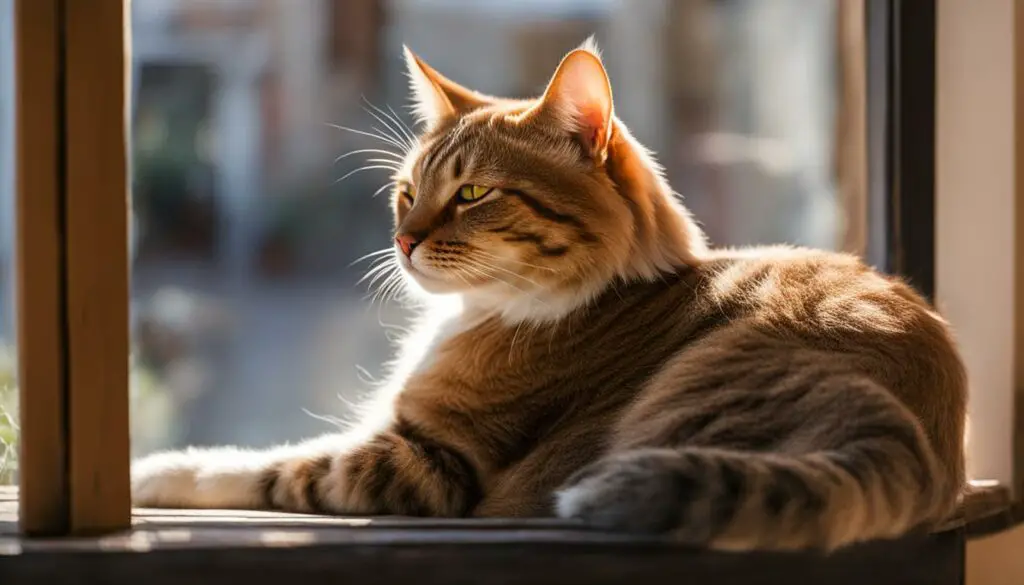
The Importance of Regular Check-ups
Scheduling regular veterinary check-ups allows professionals to assess our cats’ overall health, detect any underlying issues, and provide appropriate treatment. During these visits, veterinarians can evaluate your cat’s mobility, dental health, and perform blood tests to check for any abnormalities.
| Health Issue | Symptoms | Treatment |
|---|---|---|
| Arthritis | Decreased mobility, stiffness, difficulty jumping or climbing | Pain management, joint supplements, physical therapy |
| Dental Problems | Bad breath, difficulty eating, drooling | Professional dental cleaning, extraction if necessary |
| Urinary Tract Infections | Frequent urination, straining in the litter box, blood in urine | Antibiotics, dietary changes, increased water intake |
Regular check-ups ensure that any health issues are addressed promptly, improving your senior cat’s quality of life and minimizing the risk of behavioral changes such as increased clinginess.
Understanding the Role of Hormones
When it comes to sudden affection in male cats, hormonal imbalances can play a significant role. Reproductive behavior, marking, and mating instincts can all contribute to a cat’s clingy behavior. Neutering can be an effective solution to manage excessive clinginess associated with hormonal imbalances.
Reproductive behavior is driven by hormones and can lead to changes in a male cat’s behavior. During mating season, cats may become more affectionate as they seek out potential mates. This behavior can include rubbing against furniture or people, vocalizing more often, or displaying increased territorial tendencies.
Marking behavior, such as spraying urine, is another way male cats communicate their presence and territorial boundaries. This behavior is driven by hormones and can contribute to clinginess as cats seek to mark their territory and assert their dominance. Neutering can help reduce marking behavior and alleviate excessive clinginess associated with territorial tendencies.
“Neutering is a common solution to manage excessive clinginess in male cats. By removing the testicles, neutering reduces the production of hormones that drive reproductive and territorial behaviors.”
| Table: Neutering and Its Effects on Hormonal Imbalances |
|---|
| Benefits of Neutering |
| 1. Reduces reproductive behavior and mating instincts |
| 2. Minimizes marking behavior and territorial tendencies |
| 3. Helps manage excessive clinginess in male cats |
| 4. Reduces the risk of certain health issues, such as testicular cancer |
Neutering is a common solution to manage excessive clinginess in male cats. By removing the testicles, neutering reduces the production of hormones that drive reproductive and territorial behaviors. This can help regulate a cat’s behavior and reduce the intensity of clingy behaviors associated with hormonal imbalances.
It’s important to consult with a veterinarian regarding the timing and benefits of neutering your male cat. The veterinarian can provide guidance based on your cat’s specific needs and health considerations.
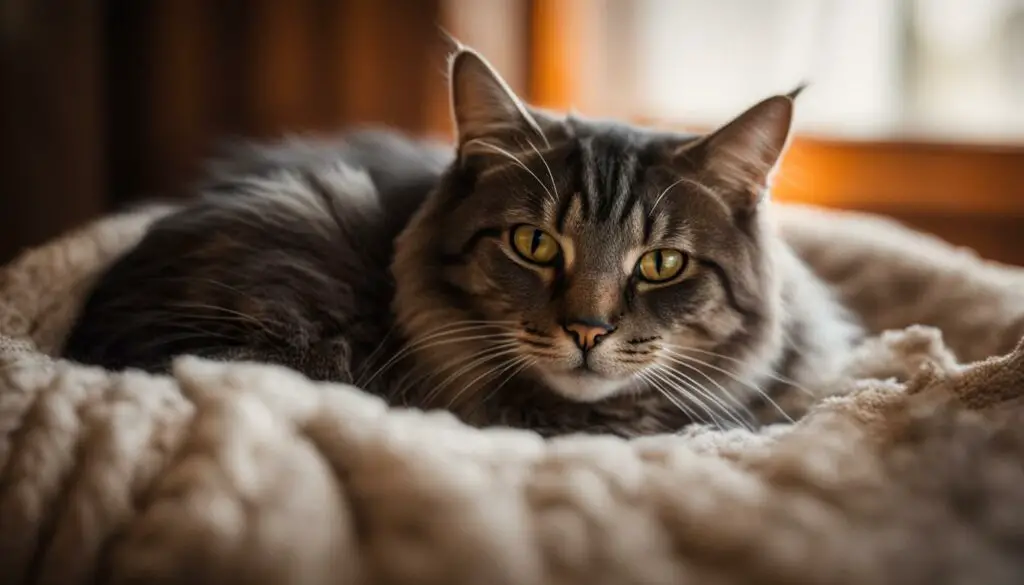
The Role of Socialization and Trust
When it comes to understanding and addressing sudden affection in male cats, socialization and trust-building play a crucial role. These factors contribute to the overall bonding and communication between cats and their owners, ultimately helping to alleviate clingy behavior.
Socialization involves exposing your cat to different people, animals, and environments from a young age. This helps them develop a confident and adaptable personality, reducing the likelihood of clinginess. Spending time with your cat in various settings and introducing them to new experiences can promote socialization and make them more comfortable in different situations.
Building trust is another important aspect of reducing clingy behavior in male cats. This can be achieved through positive reinforcement, such as rewards and treats when your cat displays desired behaviors. Additionally, understanding feline body language and responding appropriately to their cues can help foster trust and strengthen the bond between you and your cat.
Examples of Socialization Techniques:
- Introduce your cat to new people gradually, allowing them to approach your cat at their own pace.
- Expose your cat to different sounds, smells, and textures to familiarize them with diverse environments.
- Engage your cat in interactive play sessions to encourage mental stimulation and positive associations with interactions.
Tips for Building Trust:
- Allow your cat to approach you for attention and affection, rather than forcing it upon them.
- Avoid punishing or scaring your cat, as this can damage trust and exacerbate clingy behavior.
- Provide a safe and comfortable space for your cat, such as a designated area with their bed, toys, and scratching posts.
By prioritizing socialization and trust-building with your male cat, you can create a secure and balanced relationship. This will ultimately help reduce clingy behavior and foster a strong bond based on mutual understanding and companionship.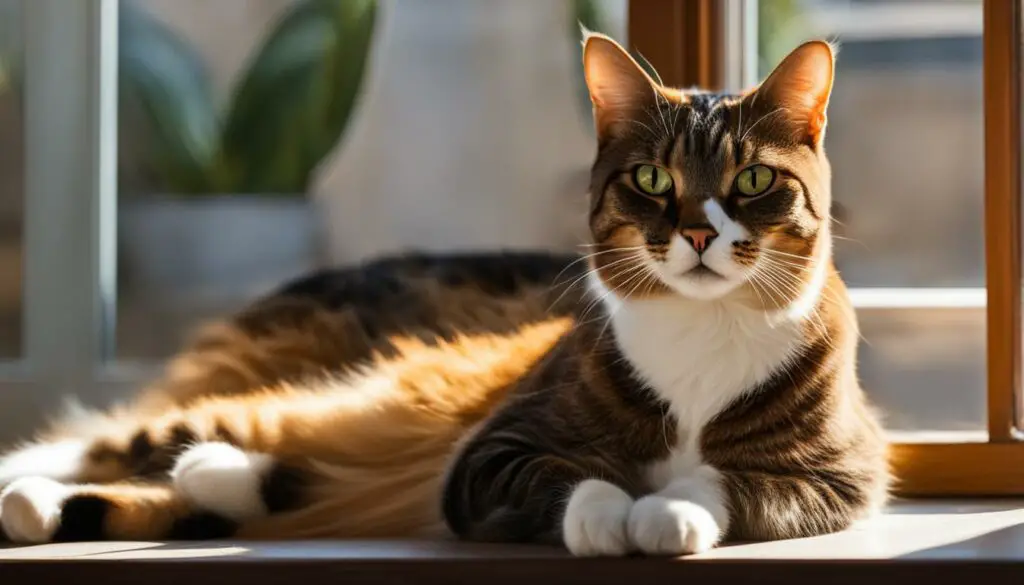
Conclusion
Understanding why your male cat is suddenly so affectionate can greatly contribute to strengthening the bond between you and your furry companion. Clingy behavior in cats can be attributed to various factors, including nervousness, insecurity, newness in the household, mommy issues, past trauma, potential health issues, and hormonal imbalances. By addressing these underlying factors, you can reduce clinginess and create a healthier relationship with your cat.
Building trust and providing companionship are key in addressing clingy behavior. Spending quality time together, playing, and providing a stable routine can help alleviate feelings of anxiety and loneliness in your cat. Additionally, maintaining a consistent environment and introducing new family members with care and communication can help ease transitions and reduce clinginess.
Regular veterinary check-ups are essential to rule out any potential health issues that may contribute to sudden affectionate behavior. Aging and hormonal imbalances can also impact a male cat’s clinginess. Neutering can help manage territorial tendencies and reduce excessive clinginess associated with reproductive behaviors.
Ultimately, understanding and addressing the reasons behind your male cat’s sudden affectionate behavior can lead to a stronger bond and a happier coexistence. By providing love, support, and a nurturing environment, you can create a harmonious relationship with your furry friend.
FAQ
Why is my male cat suddenly so affectionate?
Male cats can exhibit sudden changes in behavior, including becoming more affectionate, due to factors such as nervousness, insecurity, newness in the household, mommy issues, past trauma, a potential health issue, or hormonal factors. Understanding these reasons can help strengthen the bond between owner and cat.
What can cause nervousness and insecurity in male cats?
Changes in the home environment, such as rearranging furniture or introducing new items, can contribute to feelings of nervousness and insecurity in male cats, leading them to seek comfort and safety from their owners.
Why is my new male cat so clingy?
Male cats who are new to the household may exhibit clingy behavior as they establish their place in the hierarchy. They see their owners as a source of comfort and bonding, seeking their company for security and reassurance.
Why does my male cat have “mommy issues”?
Male cats that were separated from their mothers too early may experience bonding complications, resulting in a strong attachment to their owners. They may view their owners as their true mothers and seek a close bond with them.
Why is my rescue male cat so clingy?
Rescue cats often exhibit clingy behavior due to past trauma and trust issues. The hardships they faced before finding their forever homes can lead them to seek comfort and security by clinging to their owners.
Could my male cat’s sudden affection be caused by a health issue?
Yes, sudden behavior changes, including extreme dependence, can be indicative of underlying health issues in male cats. It is important to schedule a veterinary check-up to rule out any medical problems that may be causing the increased affectionate behavior.
How can I differentiate between clingy and demanding cats?
Clingy cats seek comfort and support from their owners, displaying behaviors like not eating unless the owner is present or constantly following them. Demanding cats, on the other hand, exhibit more confidence and may meow or demand attention to get what they want.
How can I strengthen the bond with my male cat?
Spending quality time together, playing, and providing companionship can help strengthen the bond and reduce clingy behavior in male cats.
What can I do to create a stable environment for my male cat?
Maintaining a consistent routine and providing a stable environment can help reduce clinginess in male cats. Cats are sensitive to changes in their surroundings, so keeping things familiar can provide them with a sense of comfort and security. Pheromone products and familiar scents can also help create a calming environment for cats.
How can I introduce new family members to my male cat?
Proper communication, socialization, and building trust can help ease the transition and reduce clingy behavior when introducing new family members to a male cat.
What can I do to address loneliness and anxiety in my male cat?
Providing companionship, comfort, and a stimulating environment can help alleviate loneliness and anxiety in male cats, reducing clingy behavior.
Should I be concerned about my aging male cat’s sudden affection?
Aging and health issues can contribute to changes in behavior, including increased affection in male cats. Regular veterinarian check-ups and addressing any underlying health issues can help manage clinginess associated with these factors.
Can hormonal factors influence my male cat’s clingy behavior?
Yes, hormonal factors such as reproductive behavior, marking, and mating instincts can influence a male cat’s clinginess. Neutering can help manage excessive clinginess associated with hormonal imbalances, reducing territorial tendencies and the desire to mate.
How can I build trust and reduce clinginess in my male cat?
Proper socialization and trust-building exercises are crucial in reducing clinginess in male cats. Understanding feline body language and providing positive reinforcement can help establish a strong bond and alleviate clingy behavior.

